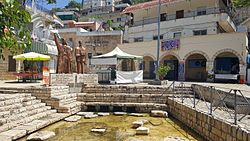Peki'in
Peki'in
|
||
|---|---|---|
| Hebrew transcription(s) | ||
| • ISO 259 | Pqiˁin | |
| • Also spelled | Peqi'in (official) | |
 |
||
|
||
| Coordinates: 32°58′27″N 35°19′53″E / 32.97417°N 35.33139°ECoordinates: 32°58′27″N 35°19′53″E / 32.97417°N 35.33139°E | ||
| Grid position | 181/264 PAL | |
| District | Northern | |
| Government | ||
| • Type | Local council | |
| Area | ||
| • Total | 3,565 dunams (3.565 km2 or 1.376 sq mi) | |
| Population (2015) | ||
| • Total | 5,658 | |
| Name meaning | The little valley (between mountains) | |
Peki'in (alternatively Peqi'in) (Hebrew: פְּקִיעִין) or Buqei'a (Arabic: البقيعة), is a Druze town with local council status in Israel's Northern District. It is located eight kilometres east of Ma'alot-Tarshiha in the Upper Galilee. In 2015 it had a population of 5,658.
The Jewish community of Peki'in has maintained a presence there since the Second Temple period, unlike the vast majority of Jews who have gone into diaspora at some point in the last two millennia. The only interruption in their presence was during the 1936–1939 Arab riots. Most Jews in Peki'in did not return to the village after the violence, which they called the Hadera diaspora. It is believed that the Zinatis are the only family who returned, and this family has dwindled to one member.
Objects such as potsherds of the Chalcolithic period were found in the village, and a burial site close by, making a 100 dunams (25 acres) settlement a possibility.
The village Baca in Josephus' The Jewish War is thought to be Peki'in. According to Josephus it marked the border between the kingdom of Herod Agrippa II, and Tyre.
A bundle of Jewish traditions is associated with a certain Peki'in often, appearing in writing under the names Baka, Paka and Peki'in, which gave rise to the theory that a Jewish community lived there continuously from the Second Temple period. According to the Talmud, Rabbi Joshua ben Hananiah run a Beth Midrash, Rabbi Shimon bar Yochai and his son Rabbi Elazar ben Shimon, hid in a cave from the Romans for 13 years, and Shimon bar Yochai went on to teach at the city. However, there is evidence that the identification of Rabbinic Peki'in with Peki'in-Buqei'a is of Ottoman time, and other sites in the vicinity of Rehovot have also been suggested. The first writing where the name Peki'in undoubtedly refers to this village is from a 1765 Hebrew travel book.
...
Wikipedia


